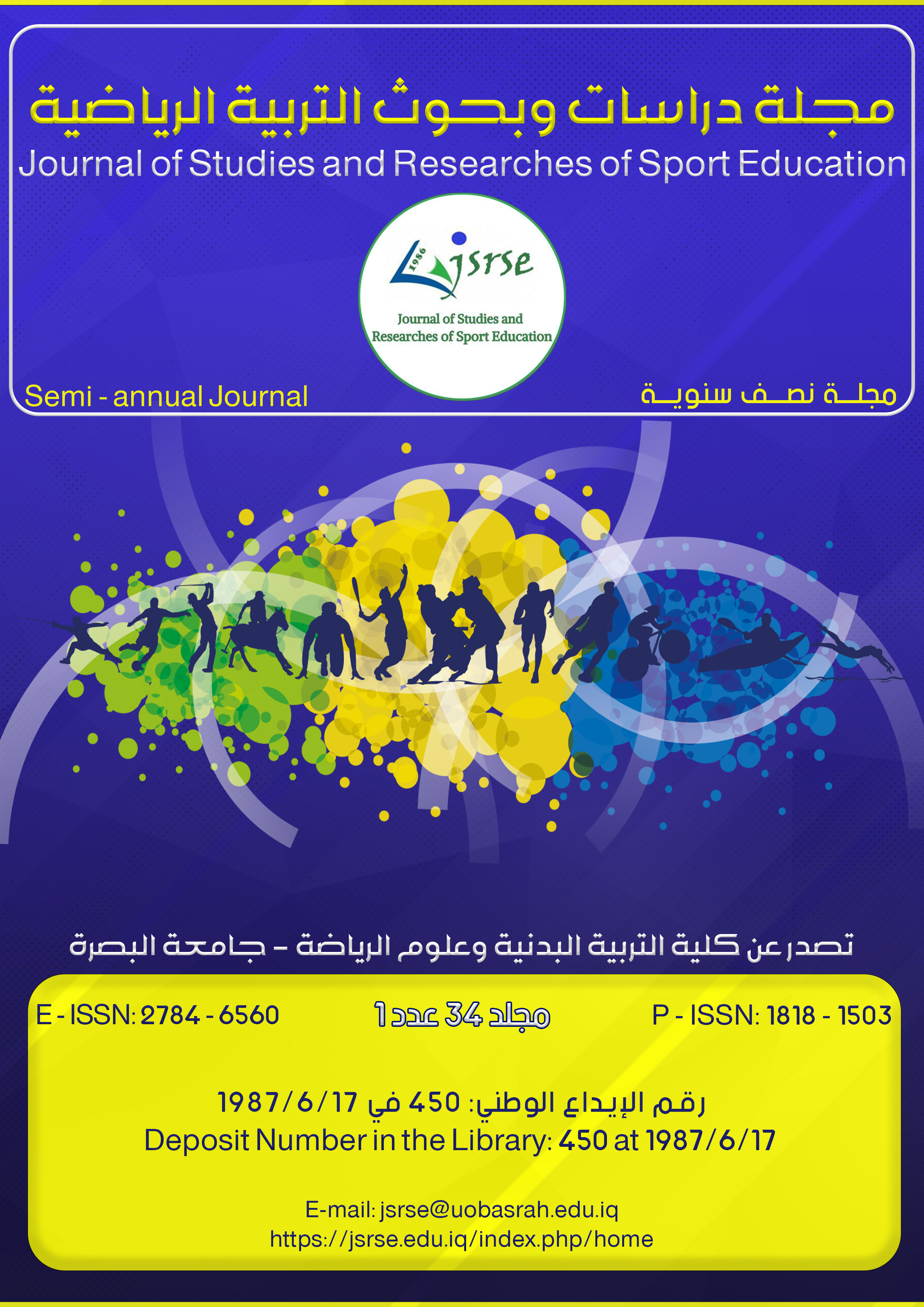الاستقرار التنظيمي لدروس التربية الرياضية: أوجه الفائدة للتنسيق العلائقي بين طلاب المدارس الاعدادية
محتوى المقالة الرئيسي
الملخص
هدف البحث إلى: - تحديد مستوى الاستقرار التنظيمي الذي تمتلكه دروس التربية الرياضية في المدارس الإعدادية التابعة لمديرية تربية بغداد الكرخ الأولى من وجهة نظر الطلاب. - تحديد مستوى التنسيق العلائقي بين طلاب المدارس الإعدادية التابعة لمديرية تربية بغداد الكرخ الأولى في أثناء درس التربية الرياضية.
استعمل الباحث المنهج الوصفي في البحث القائم على أسلوبي المسح والعلاقات الارتباطية، وحدد مجتمع البحث بطلاب المدارس الإعدادية التابعة لمديرية تربية بغداد الكرخ الأولى والبالغ عددهم (9300) طالباً، ومن هذا المجتمع اختار الباحث عينة البحث الرئيسة وقد بلغ عدد أفرادها (369) طالباً، وكان الهدف جمع بيانات عن التنسيق العلائقي بين الطلاب والاستقرار التنظيمي لدرس التربية الرياضية، وذلك عبر إعداد مقياسين لهذا الغرض واللذان تم تطبيقها بعد استيفاء المعايير العلمية اللازمة، واستنتج الباحث :
- تمتلك دروس التربية الرياضية في المدارس الإعدادية التابعة لمديرية تربية بغداد الكرخ الأولى مستوى مرتفع من الاستقرار التنظيمي من وجهة نظر طلابها - يمتلك طلاب المدارس الإعدادية التابعة لمديرية تربية بغداد الكرخ الأولى بمستوى مرتفع من التنسيق العلائقي فيما بينهم.
تفاصيل المقالة

هذا العمل مرخص بموجب Creative Commons Attribution-NonCommercial 4.0 International License.
المراجع
Abdul-Zahra, & L. H. A. J. (2013). Find extract Impact multimedia system integrated collaborative learning style in the education of the technical performance of the elevation jerk and the cognitive level of weightlifting. Journal of Studies and Researches of Sport Education, 35, 9–25. https://www.iasj.net/iasj/article/91094
Aldewan, L. H., Abdul-Sahib, H. M., & al-Mayahi, S. J. K. (2013). Platform impact media super overlap (Alhiebermedia) to learn the effectiveness of the long jump for the Deaf Mute. Journal of Studies and Researches of Sport Education, 36, 27–41. https://www.iasj.net/iasj/article/94541
Aldewan, Lamyaa Hasan, Abed Malih, F., & Abdel Karim, K. L. (2006). The effect of using the educational bag on the level of learning some offensive skills with the epee weapon. Journal of Studies and Researches of Sport Education, 19, 18–44.
Andrew Huey Jr, W., & Andrew Jr, W. (2022). Reestablishing Organizational Stability Through Leading Resilience: Avoiding the Maelstrom of Personal Distress Caused by an Organizational Disruption.
Bolton, R., Logan, C., & Gittell, J. H. (2021). Revisiting Relational Coordination: A Systematic Review. Journal of Applied Behavioral Science, 57(3), 290–322. https://doi.org/10.1177/0021886321991597
Floyd J. Fowler, Jr. C. (2014). Survey Research Methods (Fifth Edit).
Fuchs, C., & Reichel, A. (2023). Effective communication for relational coordination in remote work: How job characteristics and HR practices shape user–technology interactions. Human Resource Management, 62(4), 511–528. https://doi.org/10.1002/hrm.22161
Gallego Sánchez, M. del C., De-Pablos-Heredero, C., Medina-Merodio, J. A., Robina-Ramírez, R., & Fernandez-Sanz, L. (2021). Relationships among relational coordination dimensions: Impact on the quality of education online with a structural equations model. Technological Forecasting and Social Change, 166(January). https://doi.org/10.1016/j.techfore.2021.120608
Gilstrap, J. B., & Hart, T. A. (2020). How employee behaviors effect organizational change and stability. Journal of Business Research, 109(April 2019), 120–131. https://doi.org/10.1016/j.jbusres.2019.11.049
Gittell, J. H., Logan, C., Cronenwett, J., Foster, T. C., Freeman, R., Godfrey, M., & Vidal, D. C. (2020). Impact of relational coordination on staff and patient outcomes in outpatient surgical clinics. Health Care Management Review, 45(1), 12–20. https://doi.org/10.1097/HMR.0000000000000192
Hamal, A. M. (2022). The organization and the question of organizational stability. Introduction Journal for Human and Social Studies, 7(2), 425–444. DOI: https://doi.org/10.59791/ahssj.v7i2.2902
Iwendi, F. (2020). Labour-Management Cooperation: A Study of Organizational Stability and Survival in Skelabelt Services Limited, Nigeria 1. 4(1), 174–188.
Lamia Hassan Mohammed. (2005). The effect of a proposed educational curriculum for physical education lessons on developing the creative abilities of first-year primary school students. Journal of Studies and Researches of Sport Education, 18, 33–54. https://www.iasj.net/iasj/article/53043
Lee, H. W., & Kim, E. (2020). Workforce diversity and firm performance: Relational coordination as a mediator and structural empowerment and multisource feedback as moderators. Human Resource Management, 59(1), 5–23. https://doi.org/10.1002/hrm.21970
Obiora, O. C., & Friday, E. O. (2018). Human Resource Conservation and Organisational Stability in Nigeria. Igbinedion University Journal of Arts & Social Sciences, Vo.3(No. 1), 127–136.
Rabahi, M. (2022). Human resources development from a religious perspective and its relationship to organizational stability. In A field study at the Shoes and Leather Industries Foundation. http://dspace.univ-batna.dz/xmlui/handle/123456789/1418
Sharma, S., & Pallin, S. (2021). Structural Impact on Relational Coordination and Organizational Learning : A Study of Norwegian Organizations. June.
Spitzer, E. G., Kaitz, J., Fix, G. M., Harvey, K. L. L., Stadnick, N. A., Sullivan, J. L., Williamson, A. K., & Miller, C. J. (2023). Developing Relational Coordination: A Qualitative Study of Outpatient Mental Health Teams. Administration and Policy in Mental Health and Mental Health Services Research, 50(4), 591–602. https://doi.org/10.1007/s10488-023-01261-2
Youssef, K., & Latrash Boukhalfa. (2023). Human relations and their role in achieving organizational stability in the economic institution. In A field study in the Electricity and Gas Distribution Directorate - Tebessa. http//localhost:8080/jspui/handle/123456789/10270





 IASJ
IASJ CC-BY-4.0
CC-BY-4.0 turnitin
turnitin ISSN
ISSN DOAJ
DOAJ Crossref
Crossref GoogleScholar
GoogleScholar Orcid
Orcid